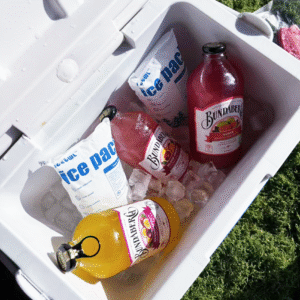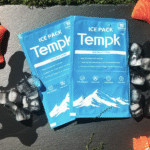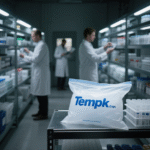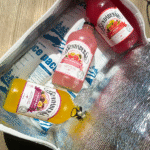If you need a precise, safe answer fast: the best all‑around choice for a 10 LB Sac à glace sec est un vented 12″ × 16″ lay‑flat LDPE (2–3 mil); for an upright packout, Utiliser un vented gusseted 10.5″ × 10.5″ × 21″ (2–3 mil). Both fit a typical 10″ × 10″ × 2–2⅜” bloc, leave fold‑over headroom, and meet 2025 handling best practices. You’ll pack faster, stay compliant, and cut breakage.
-
Lequel 10 lb dry ice bag size fits best?—with long‑tail guidance like 10 lb dry ice bag dimensions.
-
How thick should the film be?-vented dry ice bag thickness for rough handling.
-
How do you calculate bag size from volume?—a simple method you can reuse.
-
How do you pack for compliance?—labels, ventilation, et UN1845 dry ice conseils.
-
Quoi de neuf 2025?—materials, capteurs, and sustainability that affect your choice.
Lequel 10 lb dry ice bag size works best in 2025?
Réponse courte: Use a vented 12″ × 16″ 10 LB Sac à glace sec (2–3 mil) for flat “slice” blocks, or a vented 10.5″ × 10.5″ × 21″ 10 LB Sac à glace sec for upright loading. Both provide safe slack, easy fold‑over, and clean labeling. Avoid airtight closures.
Why this fit? UN 10 lb block is typically ~10″ × 10″ × 2–2⅜”. A 12″ lay‑flat width clears the 10″ face with insertion slack; 16″ height leaves room to fold without sealing. The gusseted footprint mirrors the 10″ × 10″ face for neat stacking in crates. Venting prevents pressure buildup and supports IATA/OSHA‑style handling norms.
Flat vs. gusseted 10 lb dry ice bag—how to choose
Flat lay‑flat (12″ × 16″, 2–3 mil, ventilé): Easiest to source, fast to load, generous fold‑over.
Gusseted (10.5″ × 10.5″ × 21″, 2–3 mil, ventilé): Self‑standing, tidy footprint, better for narrow crates.
Tight liner fit (≈10″ × 10″ × 3″ gusseted): Use only inside rigid liners when you want minimal air gaps and controlled headspace.
| Scénario | Recommended 10 LB Sac à glace sec | Film thickness | Ce que cela signifie pour vous |
|---|---|---|---|
| Flat “slice” block (10″ × 10″ × 2–2⅜”) | 12″ × 16″ lay‑flat, ventilé | 2–3 mil | Fast loading, reliable fold‑over, broad availability |
| Upright in crate/liner | 10.5″ × 10.5″ × 21″ gusseted, ventilé | 2–3 mil | Neat footprint, better stacking, cleaner unpack |
| Rough handling / shards | 13″ × 20″ lay‑flat, ventilé | 3–4 mil | Extra circumference for fragments; fewer tears |
| Tight inside rigid VIP/EPS liner | ~10″ × 10″ × 3″ gusseted, ventilé | 3 mil | Espace de tête minimal, sublimation plus lente (Jamais hermétique) |
Practical tips that save time and product
-
Leave a vent path. Fold—don’t heat‑seal—the 10 lb dry ice bag mouth.
-
Pré-Chill à l'expéditeur. Pre‑cooling reduces early sublimation spikes.
-
Separate cargo. Add a rigid divider to keep product off the block.
Vraie cas: A dessert shipper switched from 10″ × 12″ à 12″ × 16″ 10 lb dry ice bags (3 mil, ventilé). Tears during loading fell sharply and hold time improved, thanks to cleaner fold‑overs and better foam placement. Re‑pack errors dropped and QA cleared more outbound boxes per hour.
How do you calculate a 10 lb dry ice bag from volume?
Idée de base: Calculate block volume, add loading slack, puis ajouter fold‑over for safe venting.
Étape par étape (copy this):
-
Mass → volume: Dry ice density ≈ 1.56 g / cm³. UN 10 lb block = 4,536 g → ~2,910 cm³.
-
Typical slice: 10″ × 10″ × 2–2⅜” (≈200–238 in³).
-
Lay‑flat width: Utiliser width ≥ face + 1–2″ slack → 12″ for a 10″ face.
-
Bag height: height ≥ thickness × 5–8 to allow fold‑over and labels → 16–21″.
-
Headspace: Cible ~1″ each side or gusseted cross‑section that equals the face.
Headspace, ventilation, and fold‑over length
UN 10 lb dry ice bag needs fold‑over headroom (2–5″) et un non‑airtight mouth. Micro‑perfs, loose twist ties, or a simple fold work well. Garder empty headspace modest to slow heat ingress, but never trap CO₂.
| Block thickness | Good bag height | Good bag width | Practical meaning |
|---|---|---|---|
| 2.0″ | 16″ | 12″ | Easy fold‑over; minimal air volume |
| 2.25″ | 16–18″ | 12″ | Extra fold room for labels |
| 2.375″ | 18–21″ | 12″ | Tolerates slight block variance |
Which materials and thickness are best for a 10 LB Sac à glace sec?
Best all‑rounder: LDPE/HDPE with metallocene (for low‑temp flexibility). For most routes, un 2–3 mil vented film is ideal. Passer à 3–4 mil for rough handling, shards, or long routes.
-
Why LDPE/HDPE blends? Tough at −78.5 °C, resist haze/brittleness, and print cleanly for labels.
-
When to add a wrap? A loose kraft‑paper inner wrap reduces frost on film and cushions edges.
-
What to avoid? Thin grocery bags or non‑vented “water‑ice” bags—risk cracking and pressure buildup.
When to step up to 3–4 mil on a 10 LB Sac à glace sec
-
Sharp fragments expected: Broken blocks, frequent re‑packs.
-
Heavy conveyor handling: Automated sortation, hubs longs.
-
VIP/EPS liners with tight tolerances: Film sees more abrasion.
How should you pack a 10 lb dry ice bag for compliance?
Follow this sequence for a safer, faster packout:
-
PPE first. Portez des gants isolés et une protection des yeux.
-
Envelopper, then bag. Light kraft wrap → 10 LB Sac à glace sec (12″ × 16″ lay‑flat or 10.5″ × 10.5″ × 21″ gusseted), ventilé.
-
Rigid separator. Place a board/foam sheet above the block; keep product off direct contact.
-
Insulated outer. Use a vented cooler/shipper; crack the drain/vent or use designed vents.
-
Label outer shipper. "Glace sèche / Dioxyde de carbone, solide, UN1845” and poids net (kg).
-
Ne pas sceller hermétique. Neither the 10 lb dry ice bag nor the outer may be airtight.
-
Weigh and record. Log net dry ice for audits and customer notifications.
Quick compliance checklist (print for your bench)
-
10 lb dry ice bag vented and folded (non scellé)
-
Divider in place; no product touching dry ice
-
Outer has vent path; UN1845 marque + net kg on label
-
Packout sheet updated with starting weight and target hold time
Cold‑chain trends in 2025 that affect your 10 LB Sac à glace sec
Quoi de neuf: Vented membranes, tougher low‑temp films, and smarter liners are making every 10 LB Sac à glace sec safer and cleaner to use. Recycled and bio‑content blends are advancing without sacrificing impact strength. VIP liners and data loggers extend hold time and reduce re‑ice events.
Dernières avancées en un coup d'œil
-
Micro‑vent films: Controlled CO₂ release without manual perforation.
-
Metallocene‑rich blends: Better tear resistance with thin gauges.
-
Returnable liners: Reuse programs that fit the 10″ × 10″ footprint.
Perspicacité du marché: Demand for 10 lb formats stays high in last‑mile frozen food and biologics, favoring 12″ × 16″ 10 lb dry ice bags with clear label real estate and quick fold‑over.
Questions fréquemment posées
Q1: What’s the single safest pick for most teams?
Choose a vented 12″ × 16″ 10 LB Sac à glace sec dans 2–3 mil. It loads quickly, folds cleanly, and fits standard 10″ × 10″ slices.
Q2: When should I use a gusseted 10 LB Sac à glace sec?
Utiliser 10.5″ × 10.5″ × 21″ when you want an upright, self‑standing footprint inside a crate or liner.
Q3: Can I heat‑seal a 10 LB Sac à glace sec?
Non. Jamais seal airtight. Fold or loosely tie to maintain a vent path for CO₂.
Q4: Combien de temps un 10 lb block last in practice?
Attendre ~18–36 hours in a typical cooler. VIP/EPS systems can extend this, assuming minimal openings.
Q5: What if my blocks vary in thickness?
Design for 2–2⅜” épaisseur. Choose 16–21″ height to preserve fold‑over headroom and venting.
Q6: Do I need to log dry ice weight?
Yes—log starting net kg for labels and audits. It simplifies re‑ice planning and regulatory checks.
Résumé & recommandations
Three takeaways:
-
UN 12″ × 16″ ventilé 10 LB Sac à glace sec (2–3 mil) fits most 10″ × 10″ slices.
-
For upright packouts, pick a 10.5″ × 10.5″ × 21″ ventilé 10 LB Sac à glace sec.
-
Always leave a chemin de ventilation, add a divider, et étiqueter UN1845 + Kg net.
Étapes suivantes (do this today):
-
Standardize on one lay‑flat and one gusseted SKU.
-
Print the compliance checklist for your bench.
-
Add a divider to every packout.
-
Run a 24‑hour hold‑time test and record weight loss.
CTA: Want a one‑page spec for your line? Talk to Tempk’s cold‑chain team for a fast packout review.
A tiny decision helper (Collez dans votre sop)
Liens internes suggérés (on your site)
-
Glace sèche vs. PCM: choosing the right cold source → /knowledge/dry-ice-vs-pcm
-
UN1845 labeling checklist for dry ice packages → /knowledge/dry-ice-label-checklist-un1845
-
How much dry ice do I need for 24–72 hours? → /knowledge/how-much-dry-ice
-
Dry ice bag venting: best practices in 2025 → /knowledge/dry-ice-bag-venting
-
Choosing the right insulated shipper → /knowledge/insulated-shipper-guide
À propos du tempk
Nous concevons high‑performance cold‑chain packaging that balances reliability, conformité, et coûter. Notre 10 LB Sac à glace sec options are engineered for low‑temperature toughness, clean fold‑overs, and easy labeling. With validated packouts and quick‑start SOPs, we help your team ship on time and in temp—every day.
Ready to optimize your 10 lb dry ice bag spec? Contact our specialists for a tailored packout and a one‑page line guide.
























